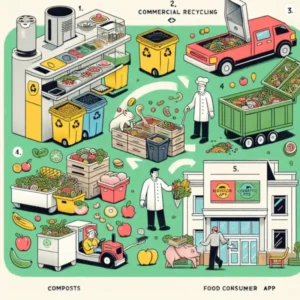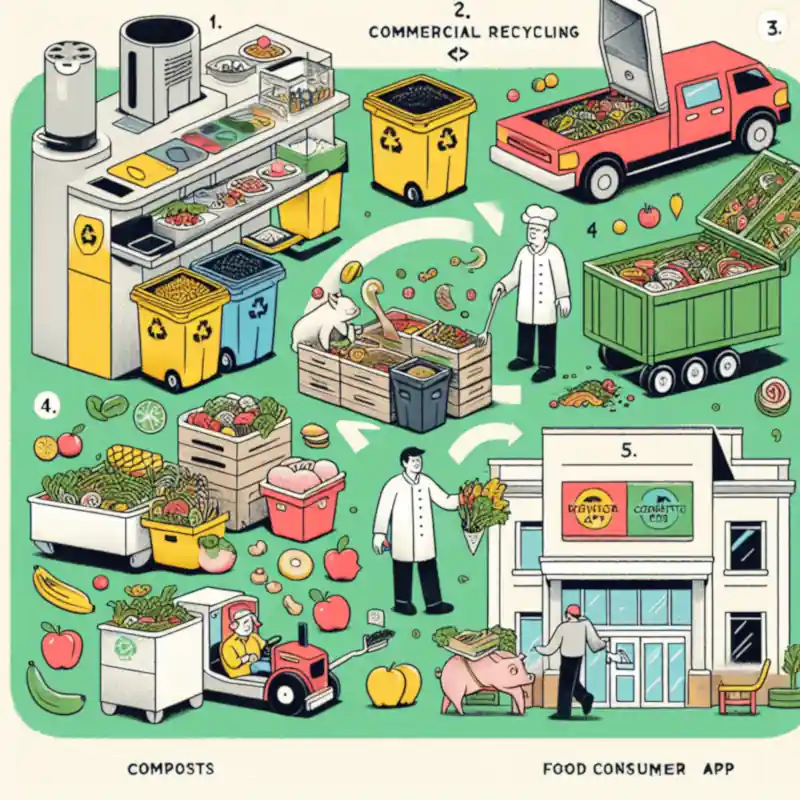Did you know that food waste is not just a commercial concern but a significant environmental issue? Understanding the implications of food waste can transform how businesses operate while contributing to a sustainable future.
What You Will Learn
- Food waste can be categorized into pre-consumer, post-consumer, and unsold food, each requiring targeted reduction strategies.
- Identifying common sources of food waste, such as overproduction and poor inventory management, is crucial for effective reduction.
- Categorizing food waste as edible or inedible allows businesses to make informed decisions regarding disposal and recovery options.
- The environmental impact of food waste includes greenhouse gas emissions and resource depletion, highlighting the need for sustainable practices.
- Businesses can save costs and enhance their reputation by adopting strategies to minimize food waste, such as waste audits and technology integration.
- Compliance with food waste regulations is essential for businesses to avoid penalties and align with sustainability goals.
- Engaging employees and local communities in food waste reduction initiatives fosters a culture of responsibility and sustainability.
Understanding Commercial Food Waste and Its Implications
Food waste is a significant issue across the globe, especially in commercial settings. Understanding the different types of food waste and their implications is essential for businesses seeking to improve their sustainability practices. By identifying the sources and categorizing the waste, companies can take proactive steps to minimize their environmental impact.
One major aspect of food waste is recognizing that it not only affects company finances but also has far-reaching consequences for our planet. Addressing food waste is not just the right thing to do; it makes economic sense for businesses aiming for long-term success. Let’s dive deeper into the various types of food waste and their implications!
Types of Food Waste Common in Commercial Settings
Food waste in commercial settings can be categorized into several types, primarily based on the origin and nature of the waste. Common types include:
- Pre-consumer waste: This type occurs during food processing and preparation.
- Post-consumer waste: This is the waste generated after food has been served.
- Unsold food: This includes food items that remain on shelves and are not sold before expiration.
Each of these categories presents unique challenges and opportunities for reduction. By understanding where waste originates, businesses can create targeted strategies to minimize it. This approach not only helps the environment but also improves operational efficiency.
Identifying Common Sources of Food Waste
Identifying common sources of food waste is crucial for creating effective reduction strategies. Some typical sources include:
- Overproduction of food items.
- Poor inventory management leading to expired items.
- Improper storage conditions affecting food quality.
By pinpointing these sources, businesses can develop tailored solutions to combat waste. For instance, better forecasting can help reduce overproduction, while improved storage practices can extend the shelf life of perishable goods.
Categorizing Food Waste: Edible vs. Inedible
Another important aspect of food waste is categorizing it as either edible or inedible. This distinction allows businesses to make informed decisions about disposal and potential recovery options. Edible waste can often be donated or repurposed, while inedible waste typically goes to composting or landfill.
To effectively manage food waste, businesses should consider implementing a clear categorization system. This can enhance recovery efforts and ensure that food that could still be consumed does not go to waste.
The Impact of Food Waste on the Environment and Economy
The implications of food waste extend beyond the immediate commercial context, impacting both the environment and the economy. Food that ends up in landfills contributes to a significant amount of greenhouse gas emissions, exacerbating climate change. Moreover, the resources used to produce, transport, and store wasted food represent a substantial economic loss.
Understanding these impacts helps to underline the importance of tackling food waste and fosters a sense of responsibility among businesses. Reducing food waste can lead to cost savings and improved sustainability, making it a win-win situation for everyone involved!
Environmental Consequences of Food Waste
The environmental consequences of food waste are profound. When food is thrown away, not only does it waste the food itself, but it also wastes the water, energy, and labor that went into producing it. Some of the key environmental issues include:
- Greenhouse gas emissions: Decomposing food waste releases methane, a potent greenhouse gas.
- Resource depletion: Unused food means wasted resources, such as water and land.
- Habitat destruction: More land is needed for agricultural production to compensate for food waste.
By addressing these environmental consequences, businesses contribute to a more sustainable future and help preserve natural resources for generations to come.
Economic Implications for Businesses and Society
The economic implications of food waste are significant for both businesses and society. Businesses face direct costs associated with waste disposal, lost revenue from unsold food, and the need to produce more to compensate for waste. On a broader scale, food waste impacts society by contributing to food insecurity and increasing the demand for resources.
To mitigate these economic implications, it’s essential for businesses to adopt strategies that reduce waste. This not only enhances their bottom line but also supports community efforts to provide food to those in need.
Greenhouse Gas Emissions from Food Waste
Food waste is a notable contributor to greenhouse gas emissions globally. When food is discarded and ends up in landfills, it decomposes anaerobically, releasing methane gas. Methane is significantly more harmful to the environment than carbon dioxide.
Reducing food waste helps lessen these emissions, contributing to climate change mitigation efforts. Businesses that take steps to minimize waste not only do their part for the planet but also position themselves as leaders in social responsibility.
Summarizing Key Takeaways on Food Waste Solutions
As we wrap up our discussion on food waste, it’s essential to highlight the critical strategies for effective management. Tackling food waste not only benefits the environment but can also lead to significant cost savings for businesses. Let’s take a closer look at some of the best practices that can help organizations minimize waste and promote sustainability.
- Implementing robust inventory management techniques.
- Establishing partnerships with local food banks for donations.
- Utilizing composting and anaerobic digestion processes.
- Leveraging technology for tracking and analyzing waste.
These strategies not only align with regulatory requirements but also foster a culture of sustainability within organizations. By adopting these practices, businesses can significantly reduce their food waste footprint.
Recap of Strategies for Effective Food Waste Management
Before moving forward, let’s recap some of the most effective strategies for managing food waste in commercial settings. These approaches can be tailored to fit the unique needs of any business, making them versatile and practical. Here are a few best practices to consider:
- Regular waste audits to identify areas for improvement.
- Integrating technology for better tracking and monitoring.
- Creating a clear food donation program to aid those in need.
- Engaging employees in waste reduction initiatives.
- Applying effective depackaging and separation according to the best guidance of the organic waste content while also collection the non-organic materials.
- Sale of the recycled pulp for energy production by feeding the pulp into anaerobic digesters while recycling the metals and the plastic and more.
By focusing on these best practices, businesses enhance their operations while contributing positively to the community and the planet. This proactive approach not only reduces waste but also generates goodwill among customers and stakeholders.
Highlighting Best Practices for Businesses
Incorporating best practices into daily operations is crucial for effective food waste management. Companies should commit to continuous improvement by regularly assessing their methods and adapting to new challenges. Here’s how they can do this:
- Set realistic waste reduction goals.
- Educate staff on the importance of minimizing food waste.
- Utilize technology to streamline inventory processes.
These actions can significantly impact a company’s overall waste management strategy. By fostering a culture of sustainability, businesses can not only comply with regulations but also inspire others to take action!
Reviewing Compliance and Regulatory Considerations

Compliance with food waste regulations is vital for businesses to avoid penalties and maintain a positive reputation. Understanding these regulations can help organizations navigate the complexities of food waste disposal. Here are some steps to ensure adherence:
- Stay updated on local and national food waste legislation.
- Maintain accurate records of food donations and waste disposal.
- Collaborate with local authorities on waste management initiatives.
By prioritizing compliance, businesses can mitigate risks and align with broader sustainability goals. This commitment not only helps them manage waste effectively but also positions them as leaders in responsible practices.
Encouraging Action and Further Engagement
As we conclude, it’s time to encourage action among businesses and individuals alike in food waste management. Engaging in sustainable practices not only benefits the environment but also paves the way for a more resilient food system. Here are the next steps businesses can take:
- Conduct regular waste audits for continuous improvement.
- Contact experts for tailored consultation and guidance.
- Utilize food waste audits to promote transparency among stakeholders.
By taking these steps, businesses can drive meaningful change in how food waste is managed, creating a more sustainable future for everyone.
Inviting Readers to Participate in Sustainable Practices
We invite everyone to get involved in reducing food waste! Participating in initiatives focused on waste reduction can amplify efforts and create a collective impact. Here’s how you can engage:
- Join local initiatives aimed at food waste reduction.
- Access resources and checklists to implement best practices.
- Spread the word through consumer awareness campaigns.
Each action taken contributes to a larger movement toward sustainability. Together, we can make a difference and reduce food waste at all levels of society!
Environmental and Economic Impact of Food Waste
Environmental Consequences
Economic Implications
Reducing food waste contributes to environmental sustainability and economic efficiency.

